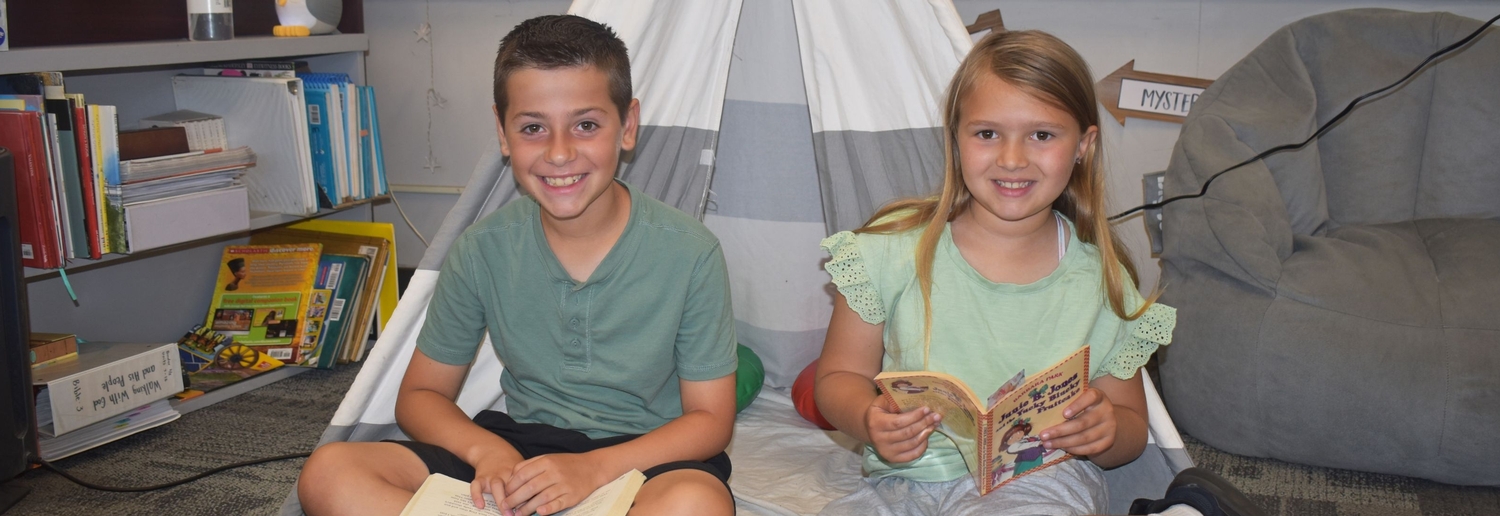
Spotlight Series: 2nd Grade Problem Solvers

This blog is part of a series for the 2022-23 school year to ILLUMINATE how God is at work at San Jose Christian School. Each post will SPOTLIGHT a specific grade level and/or program. This fourth post in the series is a SPOTLIGHT on teaching problem solving at SJCS and features interviews from: Shannon McNerney (2nd Grade Teacher) and Tabitha DeAnda (1st-2nd Learning Center and 3rd-8th Art Teacher)
Part of Our Mission at SJCS is to prepare students to “engage and transform culture for Christ,” and in order to accomplish this, Shannon McNerney says students need to learn that transformation is possible. Ms. McNerney is the 2nd Grade Teacher at SJCS, and while transformation sounds extraordinary, she says that her students have ordinary opportunities to see transformations every day in math problems, conflicts at recess, or even on a blank piece of paper.
“Problems are part of The Fall story,” Ms. McNerney said. “We're going to have problems in our lives. We can't avoid that. But teaching [students] that it's something they can work through shows them that transformation is possible.”
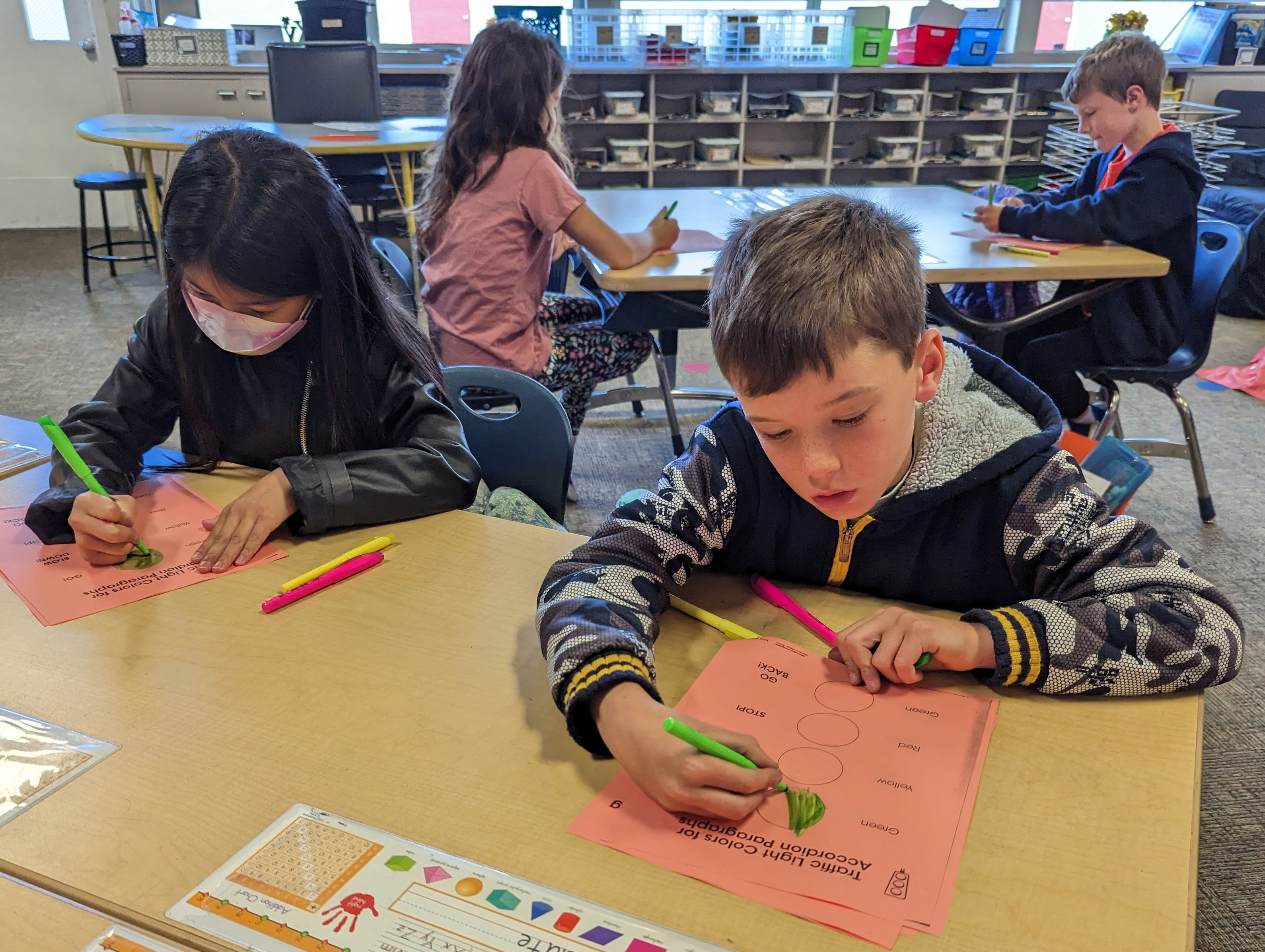
This is the “engage” part of “engage and transform.” It is necessary for students to address the problems in their lives much like they must answer the problems in their math workbooks. Problems are going to happen, but when students understand that problems can be worked through, they learn not to give up in the face of difficulty.
“The students drive those teachable moments,” Tabitha DeAnda observed. Mrs. DeAnda teaches 1st and 2nd Grade Learning Center as well as 3rd-8th Grade Art and works closely with Ms. McNerney to support and teach their shared 2nd Grade students. The two teachers emphasized that while they do not know every problem students will face throughout a day, they are very intentional in planning for and anticipating misconceptions. Their classes are set up to provide a safe environment with the tools and resources a student would need in order to work through problems when they arise.
“We're going to have problems in our lives. We can't avoid that. But teaching them that it's something they can work through shows them that transformation is possible.”
“They have access to everything,” Mrs. DeAnda said, describing the structures, visual aids, and daily routines she uses in her classroom, “so my biggest tool is teaching them how to find it.”
Mrs. DeAnda gave the example of a student who did not have all the materials they needed at the beginning of class. When this student asked for help, her response came in the form of a question: “How can I find that?” She explained that this technique gave her student the chance to think through the problem rather than being given the answer.
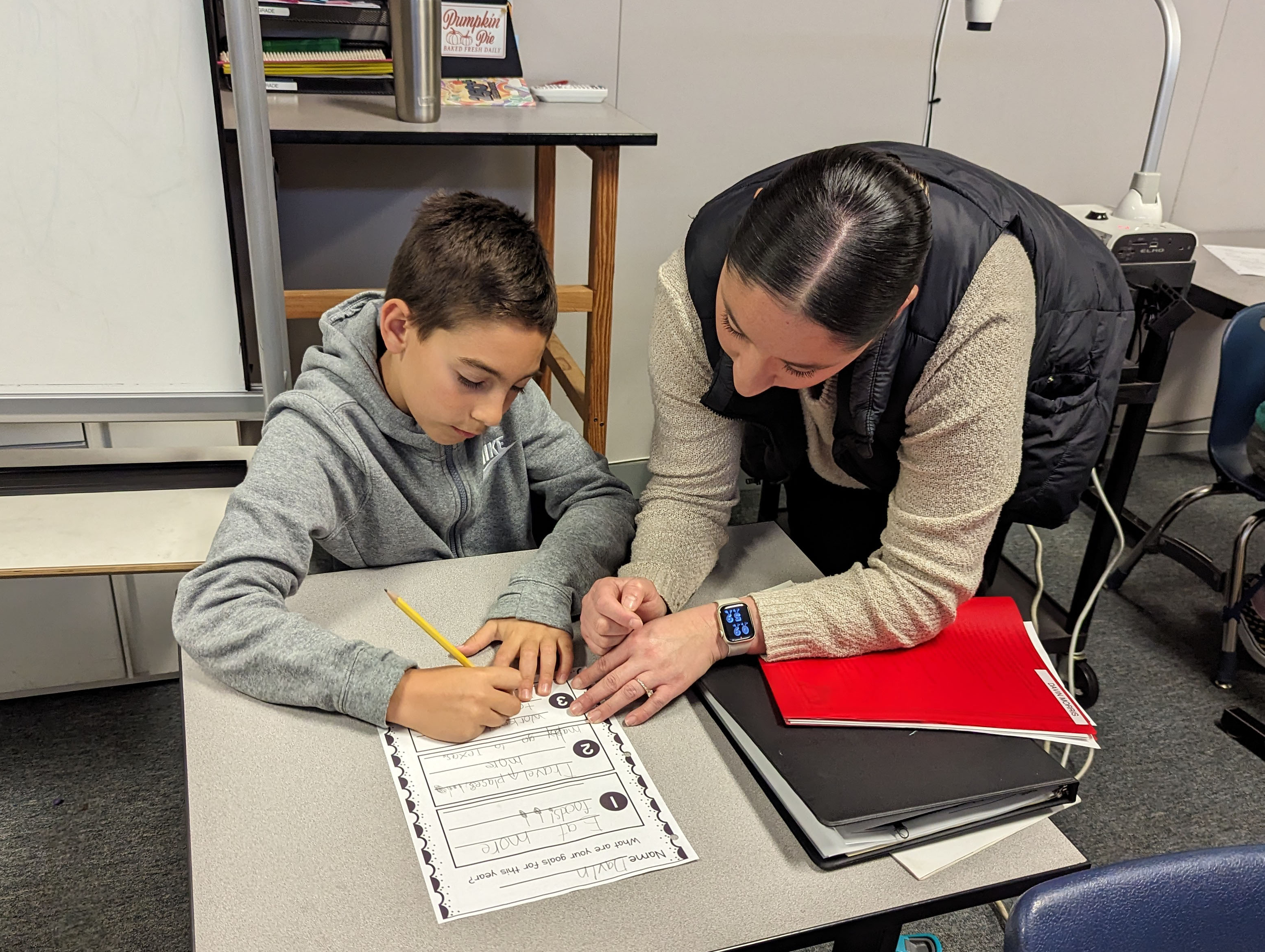
While Mrs. DeAnda could tell her students exactly what they need and where to find it, she does not believe it is always in their best interest long-term. “I like to ask questions like how can you fix that? or how can you find that?... because I want to teach students to think: if I’m in a situation where I need to do this by myself, what are the resources I can use?”
Giving students the opportunity to think through their problems creates new pathways in their brains. Mrs. DeAnda remarked, “You’re teaching them that they’re forever going to be learning… that’s the perspective and culture we want to instill in them at a very early age.”
“Where this was a struggle for them, I see that transformation where they’re not going home defeated.”
In order to foster a culture of lifelong learning, students need opportunities to practice working through challenges in a safe space. At San Jose Christian, we teach the Whole Child with an approach that recognizes the uniqueness of every student. One program available to students who are experiencing challenges with reading and writing fluency is the Learning Center. In the Learning Center, the class sizes are smaller, which allows Learning Center Teachers to provide lessons with even more individualized pacing and support to meet students’ learning needs.
“If we did not finish one of the things on the agenda, I’m not moving on and jumping in the next day just because it’s a new day,” Mrs. DeAnda said. “We’re understanding the concepts before building upon them.”
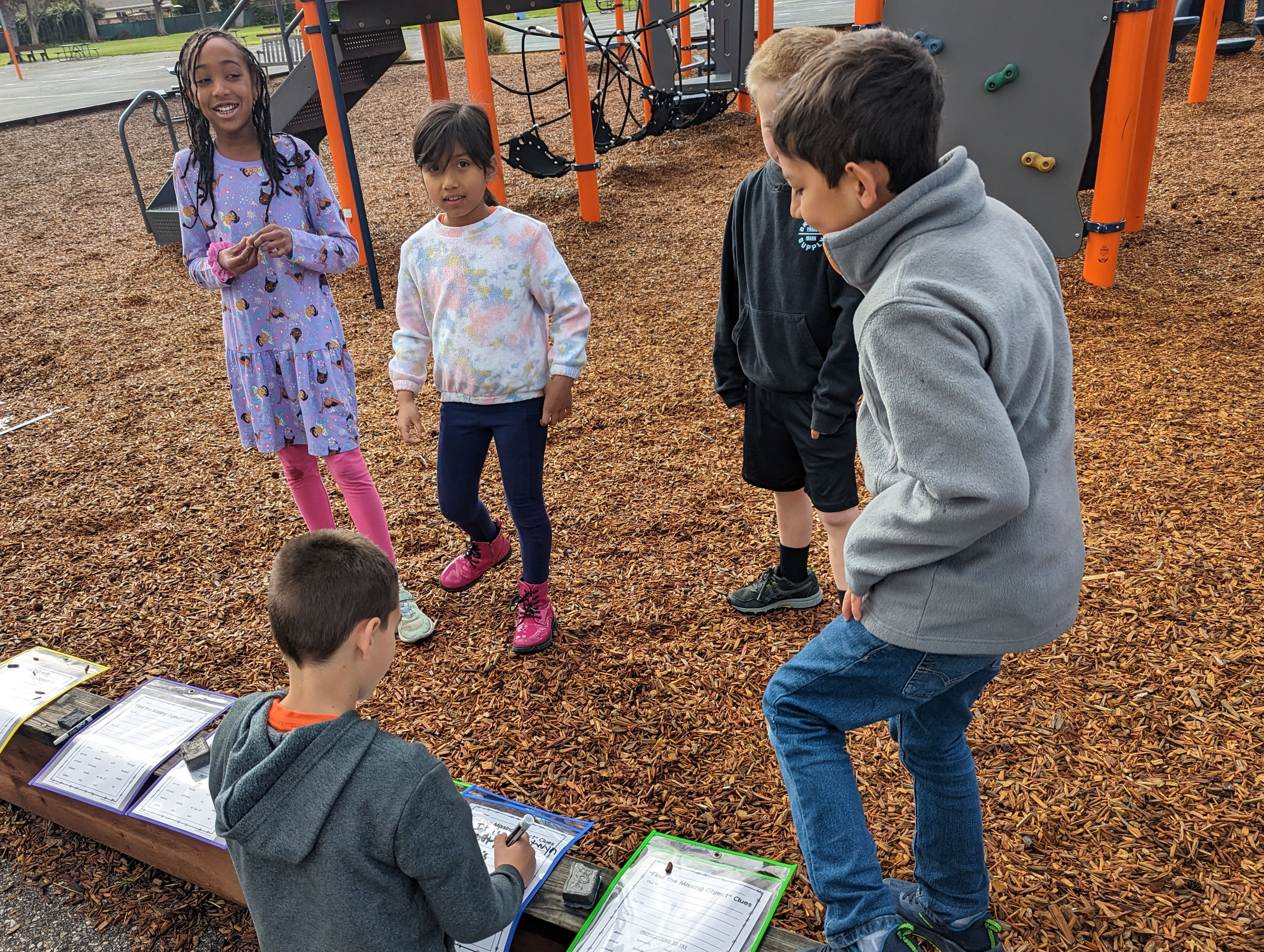
Mrs. DeAnda explained how she wants learning to be a positive experience. Creating a safe and supportive environment that allows students the time they need to learn is what makes this possible. “It gives them the space to actually dial back,” Mrs. DeAnda noted, “and for us to hone into what their needs are and provide them with the tools necessary for them to succeed in the classroom.”
And this approach makes a tangible difference for student learning. Mrs. DeAnda described the transformation she has seen in her Learning Center classroom. “Where this was a struggle for them, I see that transformation where they’re not going home defeated. I’m hearing that they love going... This is fun for them. I mean, this is hard for them, but I’m trying in every possible way to make them feel like learning is amazing.”
“Every moment you’re seeing this magical experience for them.”
Both teachers said that what they enjoy most about working with second graders is their students’ curiosity. Mrs. DeAnda added that second graders are so eager to learn. “Every moment you’re seeing this magical experience for them. It’s so groundbreaking for them because it’s the first time for them learning everything and they’re still just so curious.”
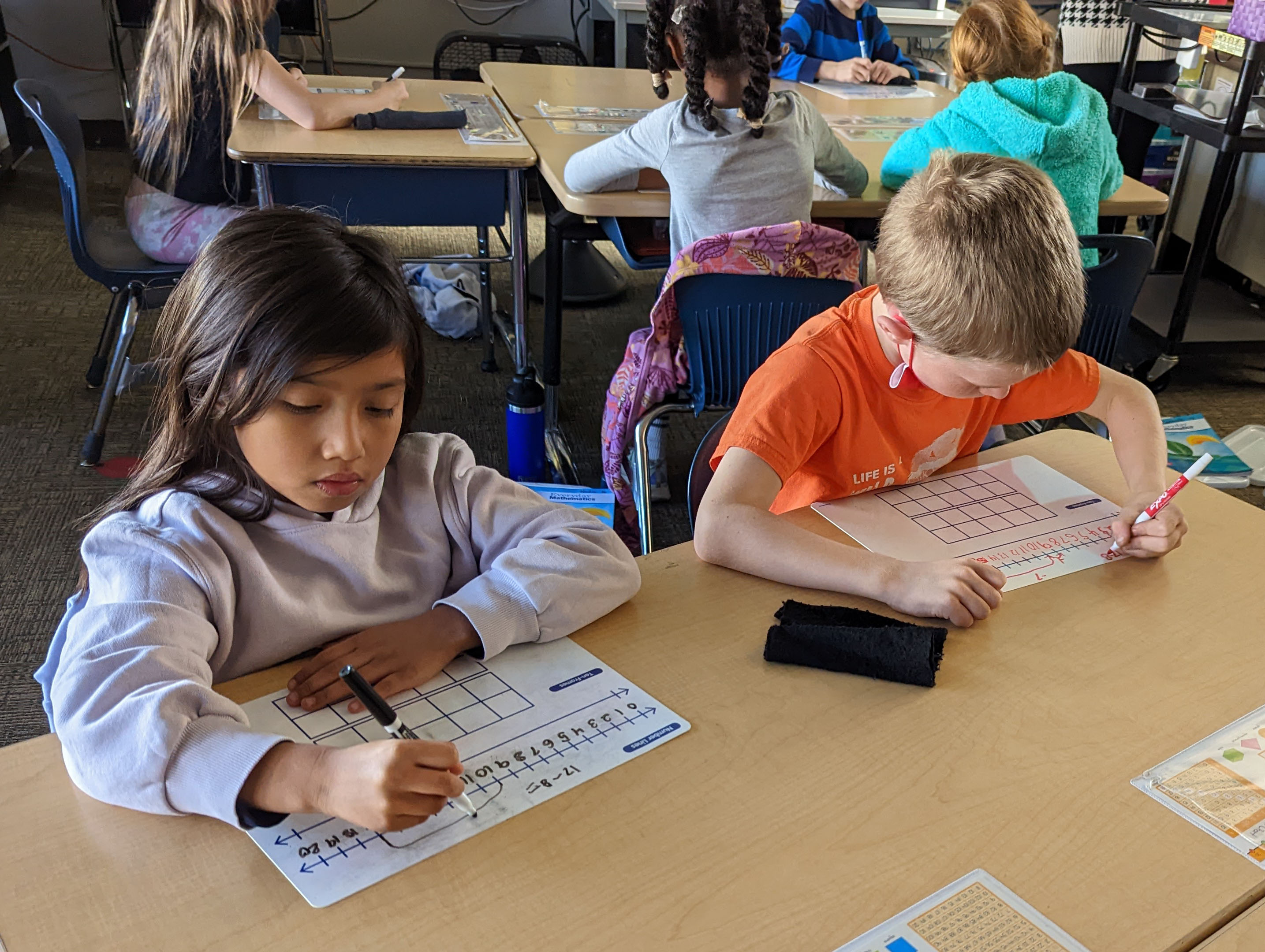
Students’ natural curiosity means they are already longing for an explanation, answer, or solution. Ms. McNerney sees their natural curiosity as an asset for teaching problem solving, especially to get students started when they feel stuck. “Something I see that's really helpful is treating [a problem] almost like a puzzle,” she said, “which can be helpful for them because it’s not looking at something and seeing it as blank… but instead thinking where does this go?” The benefit of this approach is that it breaks the problem apart and allows a student to focus on, for example, writing the first three words instead of the whole paragraph.
Embracing natural curiosity also shows students that they have problem-solving tools inside of them, which teaches not only independence but also self-reflection. “I really enjoy watching them finally be able to communicate with me,” Ms. McNerney stated. When students look inside for a solution, they can identify areas of strength and areas of potential growth for themselves.
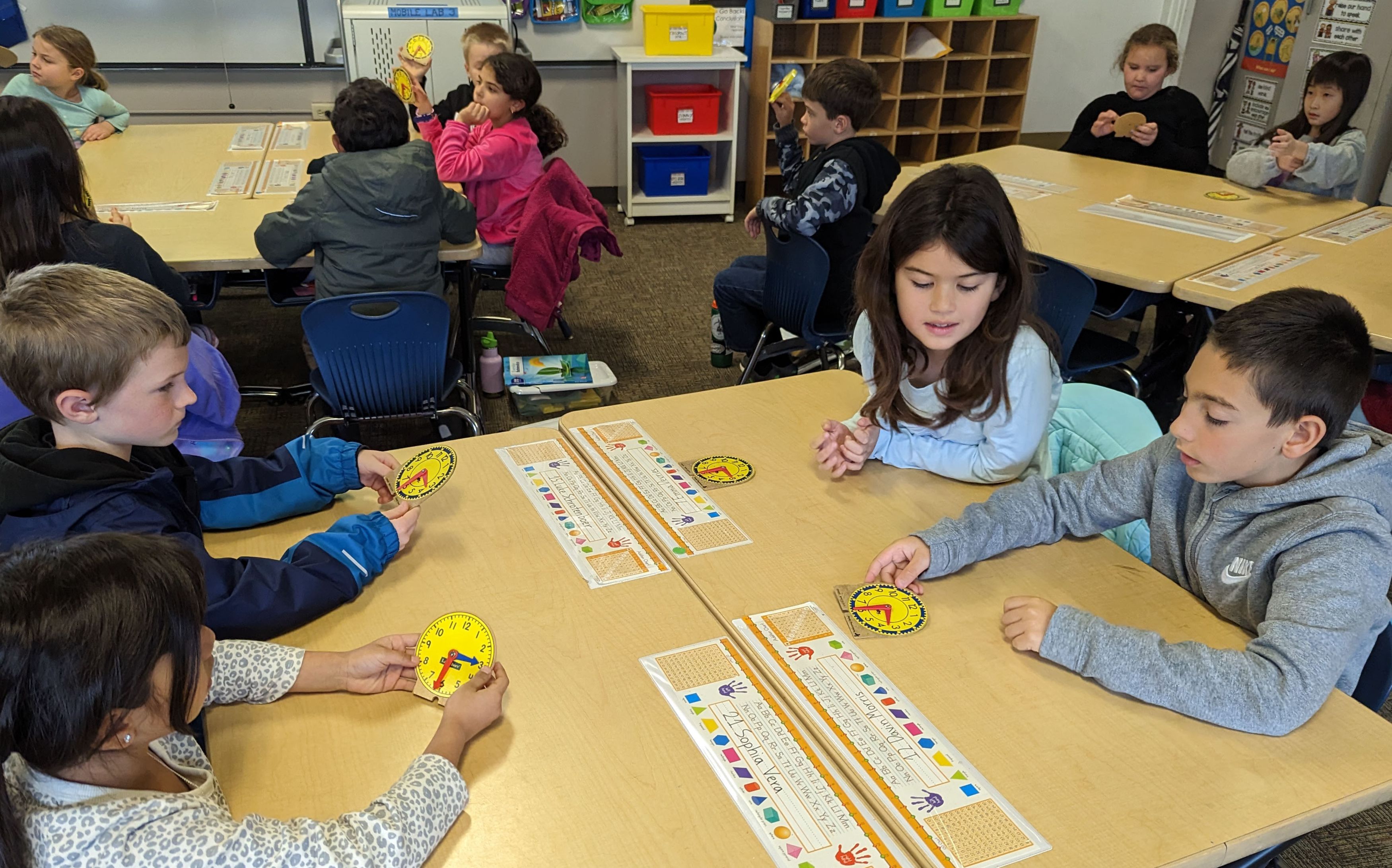
Ms. McNerney also described how when students better understand their own learning style, they can intentionally choose strategies or tools from several options. A visual learner, for example, will look for support on a poster in the room or from a color-coded chart when they get stuck, whereas an auditory learner may raise their hand to ask a question or to hear something repeated.
Additionally, Ms. McNerney explained that all the tools and strategies she provides for students become a “toolkit” that she references in class. When students are working, she says “there may be 12 different strategies given that they can use… and I like watching the kids recognize what works and what doesn't.”
“I think that problem solving can make a more student-centered classroom”
Self-reflection has the added benefit of showing students that learning is not all-or-nothing. Ms. McNerney noted this in describing how students communicate their feelings about different subjects. “There’s a switch that happens when they recognize: ‘Okay, I have certain skills that I appreciate in math, but I have a hard time with reading and writing.’” Rather than believing that because one aspect of school is difficult, they must not like school in general, these second grade students are already showing evidence of a growth mindset.
And it is important to allow students to see that learning is happening whether a task feels easier or more difficult. Both teachers mentioned that creating a safe space in their classrooms includes validating students' feelings when they find something difficult and normalizing that ability is not connected to how quickly a student can overcome a problem.
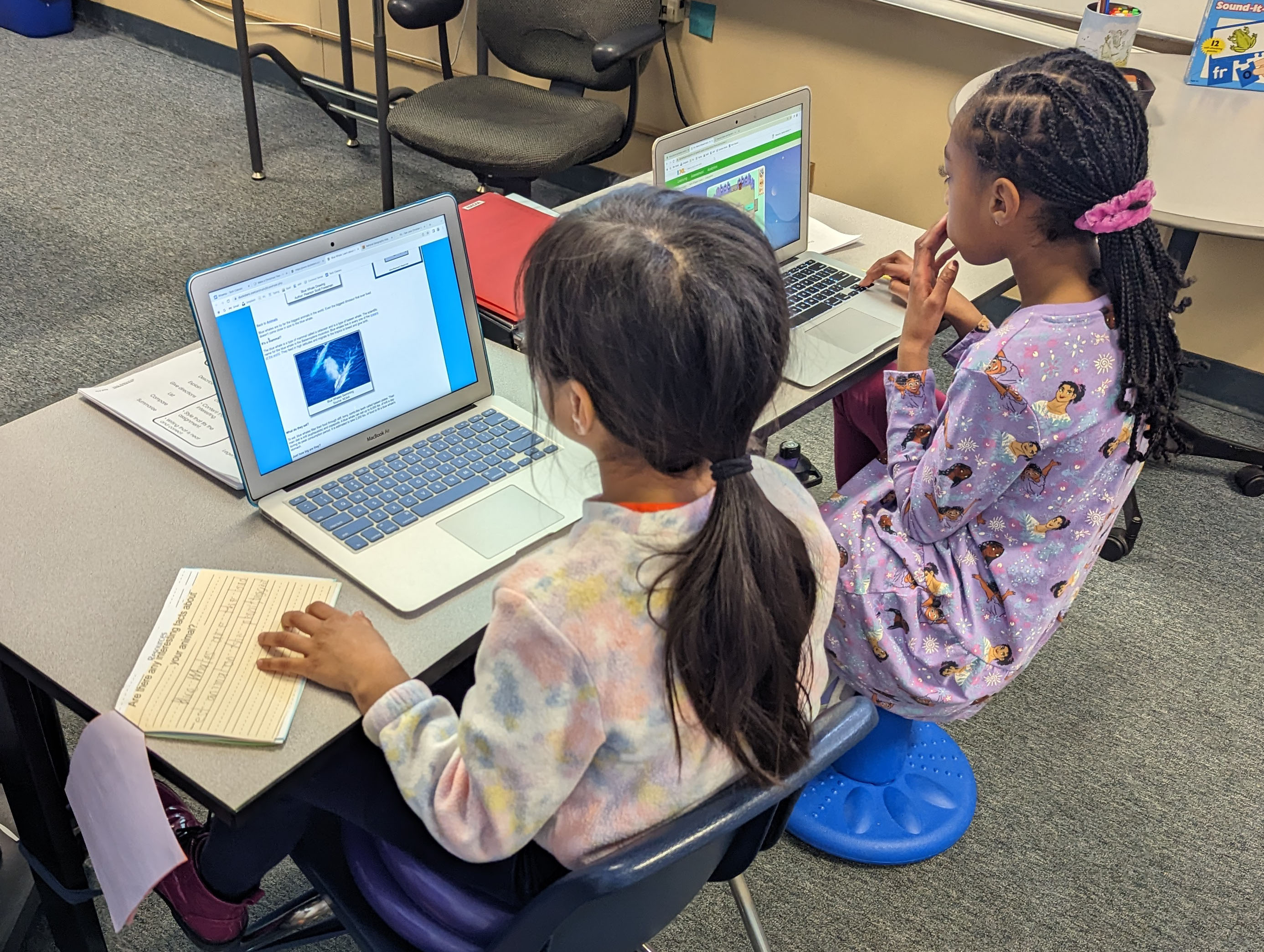
“We both will say that: I don’t know yet,” Ms. McNerney explained. And when students say: I don’t know or I can’t do it, she reframes their language. She will acknowledge that, “Yes, it is hard,” before emphasizing that they can do it, it will just require a different approach or a solution they have not tried yet.
Mrs. DeAnda added that she models this by sharing some of her own challenges and struggles. “I think we can be honest and open about ourselves and with them,” she said, adding, “We’re all learning together.”
Life is a learning process with problems and difficulties. As we prepare students to be world-changers, we are also teaching them that they are part of a community of Christians who are learning and growing as well. When students see that problems, even difficult problems, can be solved, they also see that they can be a transformed person.
“I think that problem solving can make a more student-centered classroom, which is what my goal personally is. In the end,” Ms. McNerney remarked, “they’re going to feel like: This is a place that is for me.”
Rae Sterk is the Director of Community Development at San Jose Christian.
Shannon McNerney is the 2nd Grade Teacher at San Jose Christian.
Tabitha DeAnda is the 1st-2nd Grade Learning Center Teacher and the 3rd-8th Grade Art Teacher at San Jose Christian.
Spotlight Series: Library & 1st Grade Literacy

This blog is part of a new series for the 2022-23 school year to ILLUMINATE how God is at work at San Jose Christian School. Each post will SPOTLIGHT a specific grade level and/or program. This third post in the series is a SPOTLIGHT on literacy programs at SJCS and features interviews from: Nicole Nesdahl (Librarian) and Audra Tate (1st Grade Teacher).
Connecting students with books that interest them is what makes Librarians special, particularly to elementary-age kids. San Jose Christian School Librarian, Nicole Nesdahl, cherishes this opportunity in her role; “Young children are kind of ready to hear about everything, but also about God.” She continued, adding that libraries are “special places” that provide a breadth and depth of resources children are interested in that a single home could not offer on its own.
Mrs. Nesdahl has been the Librarian at San Jose Christian School for seven years, and has been part of the SJCS community for more than twice as long. After touring the school when her son was in 1st Grade, what she admired most was the faith of the staff. “It was so evident and so clear that [faith] was just permeating everything, and it was so obvious compared with the other schools that we had visited.”
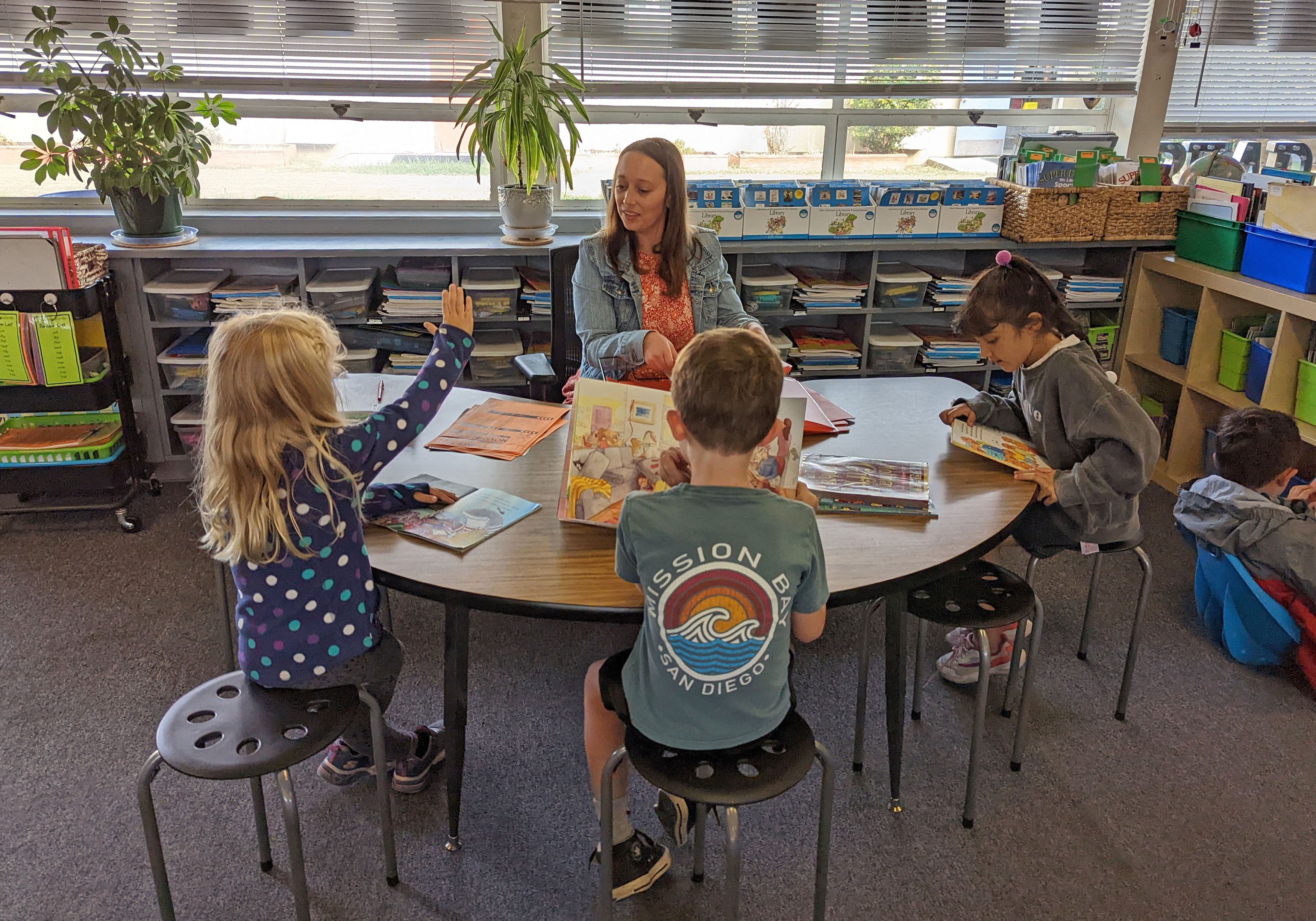
Audra Tate also started working at San Jose Christian seven years ago, for one year as a substitute teacher while finishing her credential program, and then as the 1st Grade teacher. Even as a substitute teacher, she felt “something different” at SJCS. Not only was she excited to teach a Bible lesson to her students, but she also experienced something special in the classrooms, the community at the school, and even in the students themselves.
“Everything here just felt so warm and inviting,” she remarked. During the year she subbed here, Ms. Tate said that thinking about working at San Jose Christian full-time would fill her spirit up. “When I got the key and I walked into my classroom for the first time… I fell to my knees and praised God for bringing me where He wanted me to be, teaching little kids.” Reflecting on that day now, she affirmed: “I felt like I was on God's path. I feel like I'm on God's path.”
“Young children are kind of ready to hear about everything, but also about God.”
Mrs. Nesdahl felt a similar pull to work at San Jose Christian. “I worked in public libraries for many years and I totally, I loved it, but I became increasingly aware over time that there were missed opportunities… opportunities that could be there to speak life into these kids.” This was when she felt the Spirit nudging her to work with children from Christian families.
After seven years, she still enjoys being able to incorporate Biblical perspective into the stories she reads aloud and finds it fulfilling to specifically purchase books that will build up the library’s faith section. “It is a unique opportunity,” Mrs. Nesdahl explained, “because in a lot of schools you’re not going to have that at all. And in public libraries, there might be some small faith sections, but it’s not necessarily the Christian faith.”
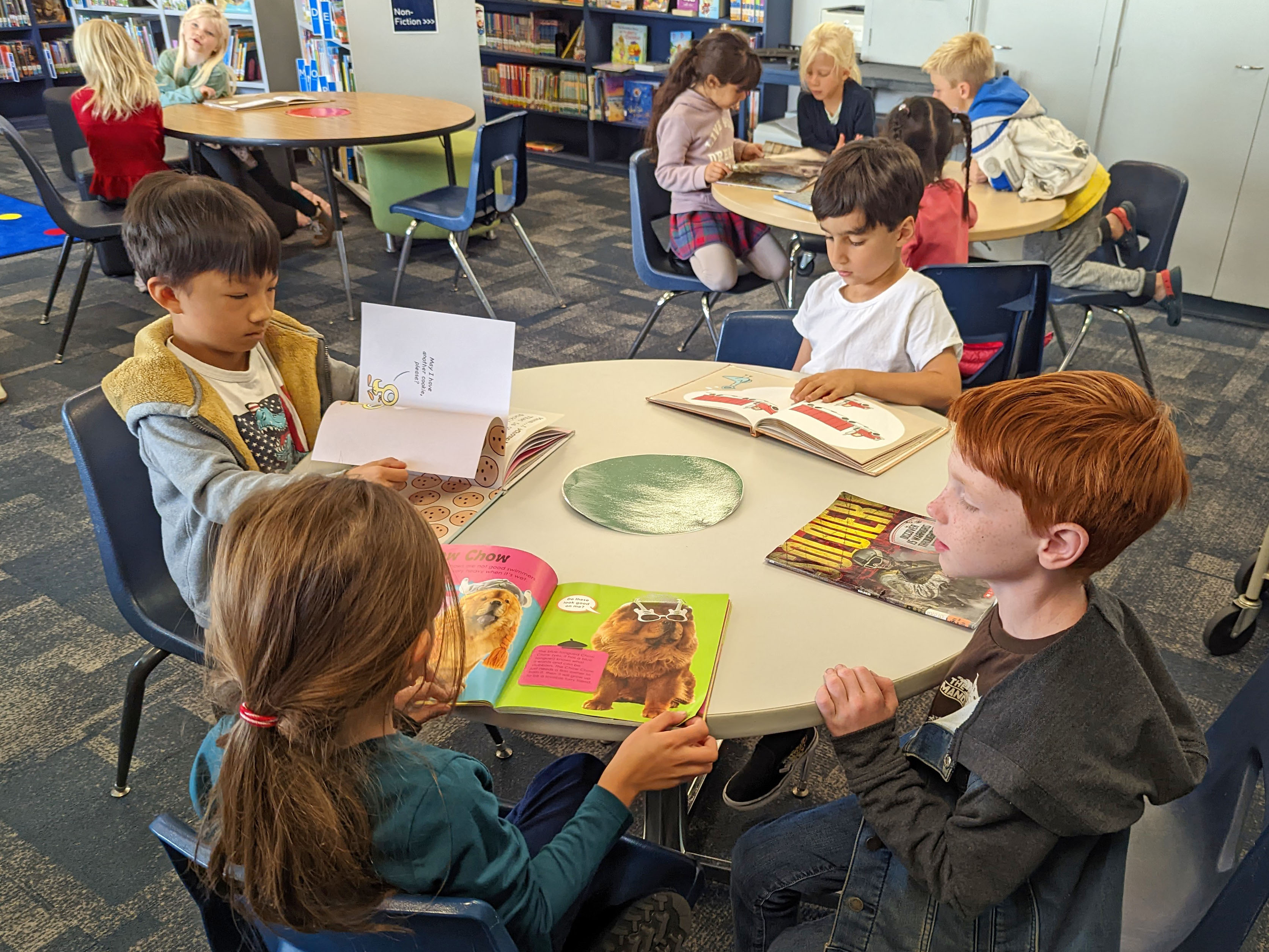
Providing these books that otherwise wouldn’t be readily available to families is one thing that students love about going to the SJCS Library each week, and parents are pleased too. “It can be challenging for families to find these resources,” Mrs. Nesdahl acknowledged, “so I feel like just providing [books about the Christian faith] is such an awesome responsibility and that adds to what this school can give.”
Having a strong library program is not only providing the right books for students to read, however; it is also about building a trusting relationship with students and their families. Mrs. Nesdahl has a unique position at San Jose Christian because she gets to work with students in all grades from JK-8 across the years they are here. She loves connecting with students and learning about their interests, which also helps her with supporting their literacy development. “As the students and I grow in our relationship, they get to know and trust me, and so as I come alongside them, they know they can rely on me to recommend good books that will grow their literacy skills.”
“Once we learn how to read, we're unstoppable, because everything in God's Word is so powerful and he wants us to know it and live it out.”
Student interest is critical both for teaching reading and for supporting a life-long love for reading. It is also what makes reading fun and desirable. Ms. Tate believes that developing a love of reading means giving students “a book they can fall in love with.” She said it starts with helping them find something that they're interested in and then“putting that in front of them, a lot of it in front of them and then asking them questions.”
Ms. Tate is also mindful of student interest in her 1st Grade classroom when she creates opportunities for students to make personal connections. “I try to make real-world situations come alive, books come alive, characters come alive.. I try to make it a little more exciting.”
One of the ways Ms. Tate brings stories to life in 1st Grade is through a grab bag activity. In this activity, she fills a bag with items representing a character in an upcoming story, and then students have the chance to touch the supplies and make predictions about this character. It’s a hands-on activity that allows students to make a personal connection with a character before meeting them, and Ms. Tate observes that it gets students excited to read.
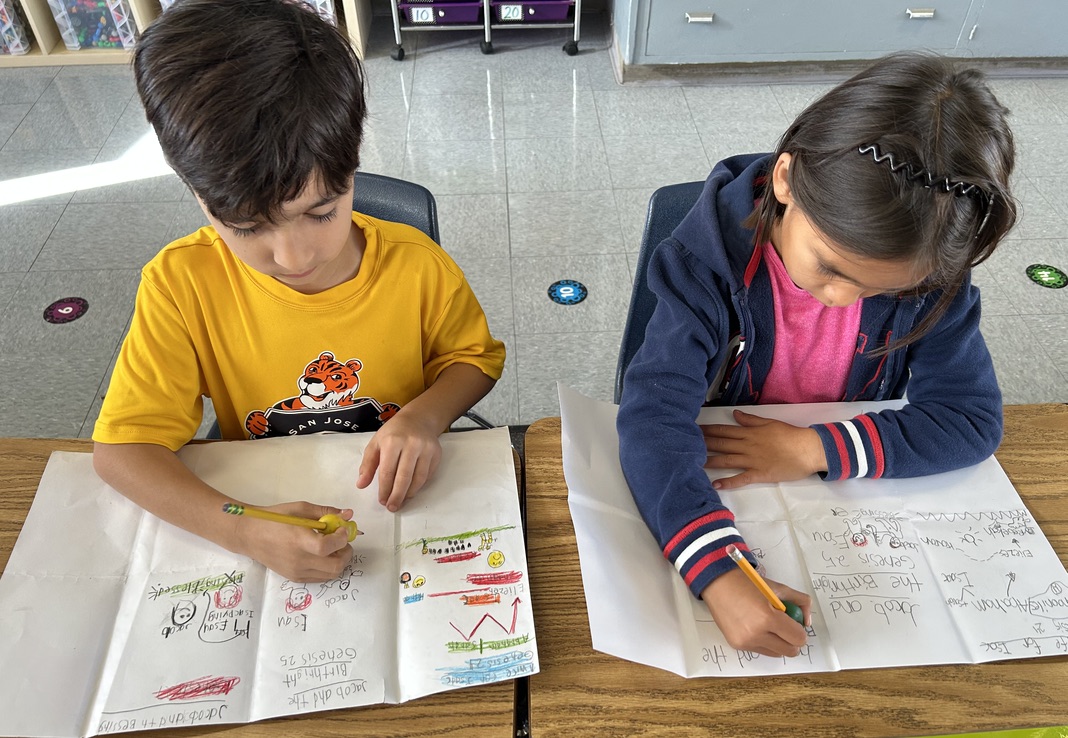
Another 1st Grade literacy activity that excites students is Bible story maps. Ms. Tate wanted to support reading comprehension in class by giving students something to do while they read Bible passages. After folding a large piece of construction paper into squares, students draw what they hear in the Bible story as the class reads it. “They love it,” she said. “Then when they're all done, they have this huge map that is all about the story in the Bible we just studied, and they are so excited to share it with everybody.”
Similarly, Mrs. Nesdahl described how she sees students internalize Bible stories in Library. After teaching students about the oral storytelling tradition, Mrs. Nesdahl shares how the Bible is part of this tradition and we are called as Christians to preserve and pass on the stories God has given us. Students get to practice this during Easter, when she uses Resurrection Eggs to tell the story of Jesus’ power over sin and death. After presenting the Easter story in a variety of ways, the students are ready and confident to share the story themselves. “By the end of that week, man, they know it, and they don't need to read it. They can just tell you if they see [the eggs]… they just know from us going over it.”
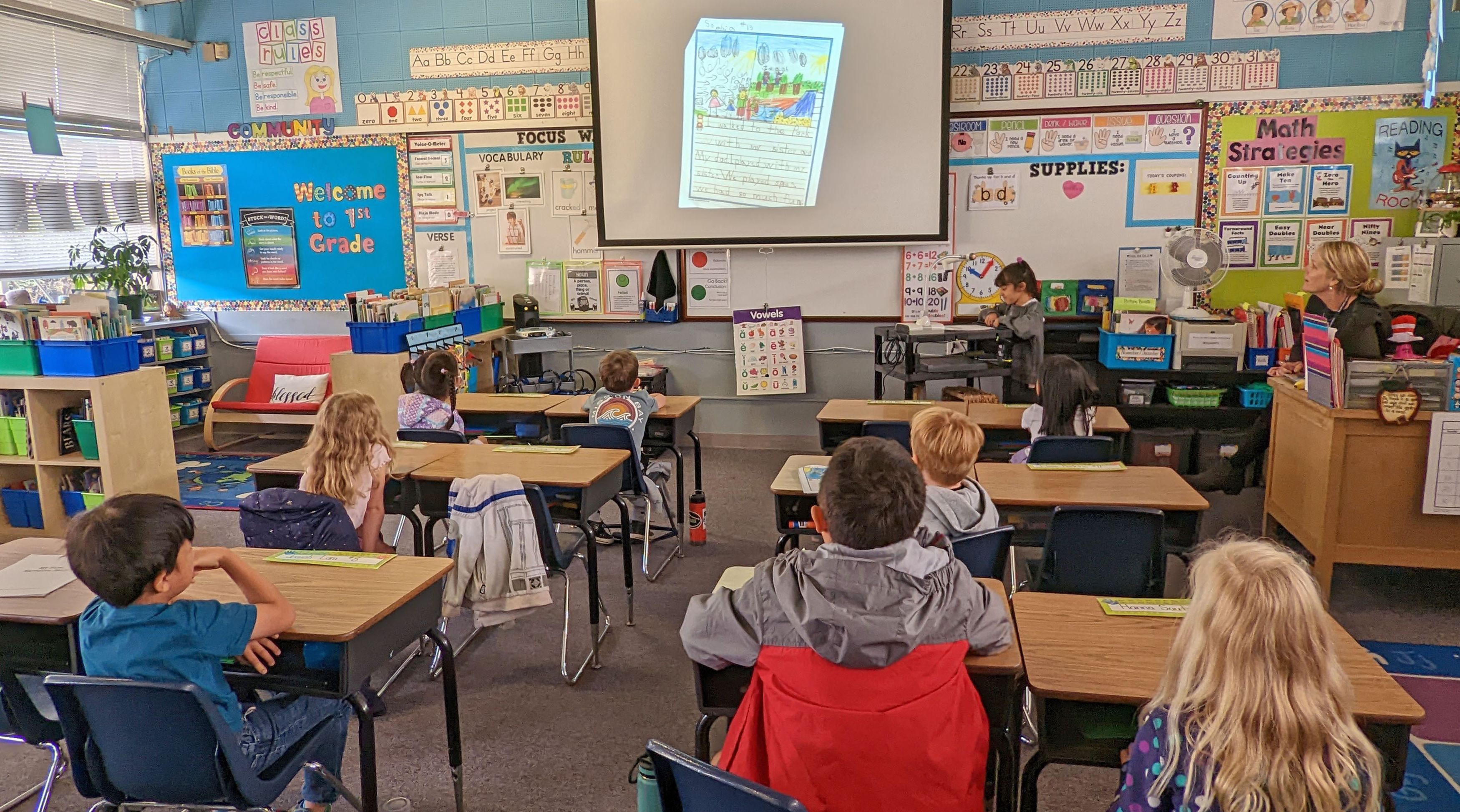
These literacy activities make stories memorable and meaningful, but Mrs. Nesdahl and Ms. Tate are also modeling for their students how to share the Gospel. By teaching students to follow God and to read simultaneously these teachers are preparing students to transform culture for Christ. Ms. Tate put it this way, “Just like we sit there and mouth how to make the proper long and short valve sound of ‘a’, we model the daily and long-term behaviors of a Christian.”
Learning how to read is as empowering as it is world-changing. Ms. Tate tells her 1st graders that once they learn how to read they will be “unstoppable,” because “everything in God's Word is so powerful and He wants us to know it and live it out.”
“Just like we sit there and mouth how to make the proper long and short valve sound of ‘a’, we model the daily and long-term behaviors of a Christian.”
Mrs. Nesdahl is also empowering students by creating roles like “library assistants” and “checkout assistants.” During Library, students take a participatory role in checking out and recommending books to their peers. Even as young as 1st Grade, students will help their friends who have not found a book by suggesting titles and explaining why they would be a good choice. Mrs. Nesdahl has created a supportive environment where students trust and rely on her and each other, while also helping students grow more confident and independent.
“We have the five finger rule,” Mrs. Nesdahl explained, “which has to do with turning the first page and every time you read a word that you don’t know, you put up one finger and then another and another.” This strategy helps students determine if a book will be too challenging or too easy for them. She encourages students to try books that have new words, but also builds their confidence by allowing them to choose what they read based on their comfort level. “And then as they grow older, they begin to know – either by length, by section, by AR level – what books are good for them.”
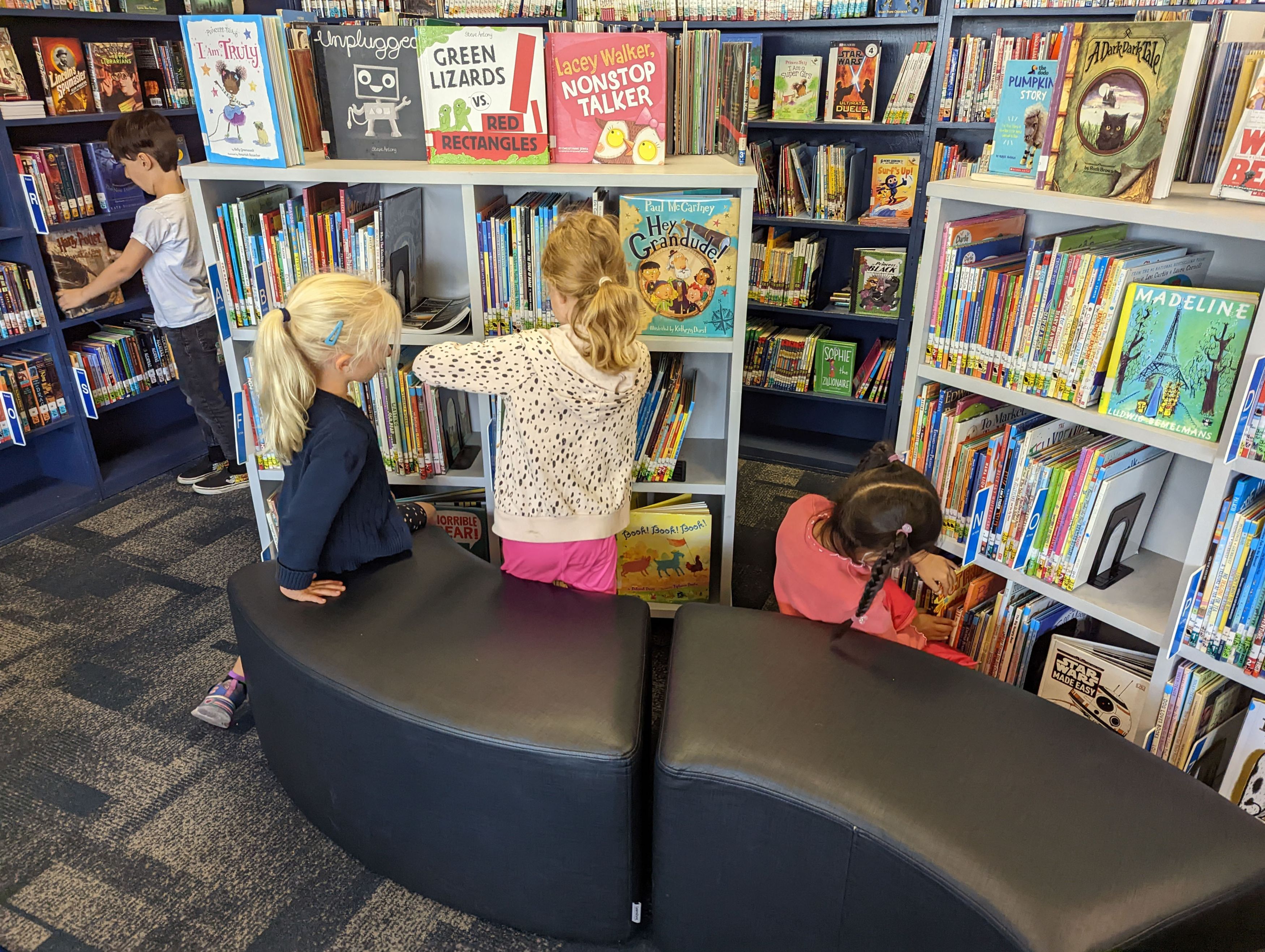
When students struggle to choose books themselves, or struggle to find a book that is appropriate for their reading level, they can find support in several places. For example, Mrs. Nesdahl described the benefit of offering graphic novels or pictorial books to students who have difficulty reading. “They might be concentrating so hard, their brain is not making pictures in their head because they're working so hard to read. And so, having that picture provides a little bit of brain relief, but keeps it moving and then they can continue on and then they build confidence as readers.” For other students, there is support through technology such as the Accelerated Reader system, which adapts to student reading level, or audiobooks, which provide a second mode for interpreting the text.
“It benefits everyone when we have more learners and readers.”
“It benefits everyone when we have more learners and readers,” Mrs. Nesdahl remarked. Fortunately, fostering a community of strong readers is something San Jose Christian is able to do well because of our small class sizes, academic scaffolds, and outstanding staff. Family support is also key to developing a love for reading, because it is evident when students read at home or see their parents reading. “We have a strong community of readers,” Mrs. Nesdahl noted, “I can tell the parents are educated and learners themselves.”
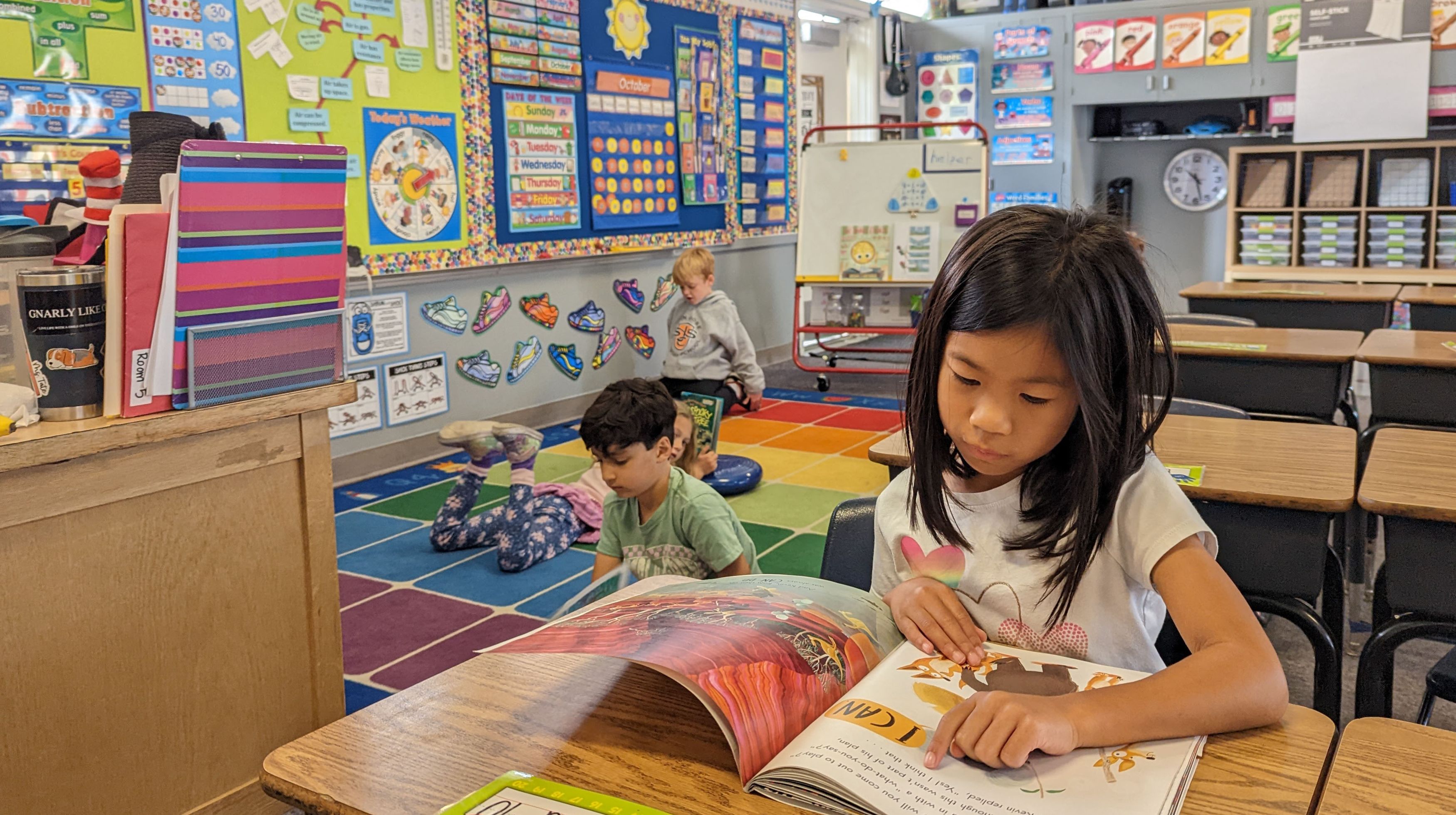
Ms. Tate recognized her students’ excitement about reading recently when she asked them what was on their Christmas lists and noticed that many of the items they wanted were books. She surmised that since her 1st graders are learning how to read, it is new and exciting, so they want more books to consume. “It's like learning how to ride a bike. Then you want the bell, you want the helmet, you want everything, right? Our students are learning how to read and getting better at it and their confidence is growing.”
Mrs. Nesdahl has a solution for parents looking to get more books in their children’s hands this Christmas. The Scholastic Book Fair will be at San Jose Christian November 28 - December 1 in the Library from 8:00-9:00am and 2:45-5:00pm. We hope to see you there!
Rae Sterk is the Director of Community Development at San Jose Christian.
Nicole Nesdahl is the Librarian at San Jose Christian.
Audra Tate is the 1st Grade Teacher at San Jose Christian.
Spotlight Series: JK & Kindergarten Active Learners

This blog is part of a new series for the 2022-23 school year to ILLUMINATE how God is at work at San Jose Christian School. Each post will Spotlight a specific grade level and/or program. This second post in the series is a spotlight on the Junior Kindergarten and Kindergarten classes and features interviews from: Mrs. Mariza Campista (Junior Kindergarten / Kindergarten Combo Teacher) and Mrs. Suzie Van Ewyk (Kindergarten Teacher).
“You kind of have to be codependent.” Mrs. Suzie Van Ewyk said about teaching Kindergarten. “Not in a negative way, but you love being with [the students] and, you know, they love being with you.”
Mrs. Van Ewyk has been on staff at San Jose Christian since 2013 and has worked in many of our Early Childhood programs. At San Jose Christian, she has taught Junior Kindergarten (JK) and Second Grade in addition to being the Preschool Director to open the Infant Care Center. For the past three years, Mrs. Van Ewyk has been the Kindergarten Teacher.
“We love our job,” added JK / Kindergarten Combo Teacher Mrs. Campista. “We’re here because we like to see the kids.” This is Mrs. Campista’s first year teaching Kindergarten, having previously taught Junior Kindergarten and Preschool. She continues to teach Preschool at San Jose Christian in the summer.

Both Mrs. Campista and Mrs. Van Ewyk have a Montessori teaching background and have worked closely together at San Jose Christian for the past seven years. These two teachers are beloved by our community and show us everyday how much they love their vocation and this school. “Yes, we have to have a paycheck, but I would still do this until I’m cold in the grave,” Mrs. Van Ewyk said, laughing. She added that she could not imagine doing anything else or even retiring: “They would have to kick us out.”
Seeing students grow into themselves and grow in their faith is what gives these teachers the deep passion they have for teaching in JK and Kindergarten. “It’s the light bulb at the end of the year,” Mrs. Suzie Van Ewyk reflected. “They become independent and they become their own person, autonomous from their parents, which is very fascinating to see.”
“It’s the light bulb at the end of the year. They become independent and they become their own person.”
Mrs. Campista added that she loves the spontaneity and the honesty of her students. Mrs. Van Ewyk agreed, noting: “You see the best in humanity and the worst in humanity with Kinder. They do not hold back.” Both teachers value this genuineness because they recognize that it comes from students feeling secure in who they are as they are developing their own, unique personalities.
Both teachers described teaching JK and Kindergarten as an important opportunity to develop students’ confidence, responsibility, and awareness of those around them. Mrs. Van Ewyk pointed out, “Developmentally, they're just coming out of that egocentrism, and we're kind of helping guide them through that transition time.” She went on to explain that the way they do this is by setting up the class with several opportunities to share and to listen, to accept guiding feedback and to teach one another.

Sharing is one class activity where this is exemplified. At the end of a day, students will individually stand at the front of the class and talk about an object they brought from home. They are free to share what they want about the object, and then they answer questions from their peers about it. In this activity, students must be aware of their audience by practicing appropriate volume and engaging their listeners. Students who are not sharing get to practice taking turns, purposefully listening, asking questions, and showing interest in those around them.
Another JK and Kindergarten class activity students engage in is Jobs. For every skill taught in the curriculum, Mrs. Campista and Mrs. Van Ewyk provide students with a manipulative task to practice that skill. These manipulative tasks are placed on the shelves in the JK / Kindergarten classrooms to be practiced each day during the unit. Jobs are self-guided and help students grow as autonomous learners. Mrs. Campista explained: “They're responsible to go get their rug, they're responsible to go get their job, they're responsible to put it away after they're done, they have to check with the teacher to go check their job, and they have to put it away.”

In addition to teaching responsibility, this active learning process helps students be self-directed learners and critical thinkers. They are able to explore a variety of learning styles, and teachers and students alike can see which learning style works best for them. As a result of this process, Mrs. Van Ewyk explains that students realize at the end of the year: “I'm capable of doing much more than I did before.”
“When a student is able to be honest and feel safe in that honesty and know that they're going to be valued… that’s God’s light in them.”
Mrs. Campista described how she incorporates activities for a variety of learning styles in her classes with Bible stories. “We do one Bible story for the whole week and we do it in different ways, not just reading it.” She explained that she starts by reading the Bible story to them and then provides opportunities for students to retell, represent, and recreate the story with a variety of activities such as a hands-on art project or a song. In this way, value is placed on student response, which not only helps them develop academically, but also develop in their faith.

Whether they are aware of it at this time or not, these JK and Kindergarten students are taught that their response matters, which prepares them to be active in their personal faith and in their faith community. When learning happens in an active process that requires active participation, Mrs. Campista and Mrs. Van Ewyk are preparing students to engage and transform culture for Jesus Christ.
Later this month, Mrs. Van Ewyk’s Kindergarten class will be going on a field trip to Bernal Ranch to connect their class topic of “Gathering In” during the Fall season to the real world. “So we're talking about earth, we're talking about: ‘This is our planet. How do we care for our planet? What does it look like, you know, to be good stewards?’” The field trip will give students a real-world example of how people harvested in the past and what we do now. She wants them to make the correlation that caring for the earth is “why we are here, and it is what God wants us to do.”

“We’re just planting the seeds, right?” Mrs. Campista remarked. “We're planting the seeds for the future” At their young age, the most important thing these JK and Kindergarten students can learn is that they are loved and that they are a child of God. Both teachers pointed out that Kindergarten is a time when children start to discover who they are as individuals, making it a special opportunity to teach these students who they are in Christ and to prepare them for the role they have to play in the larger community of believers.
“That’s what we’re here to do,” Mrs. Campista concluded, “to open their vision.”
Rae Sterk is the Director of Community Development at San Jose Christian.
Mariza Campista is the Junior Kindergarten & Kindergarten Combo Teacher at San Jose Christian.
Suzie Van Ewyk is the Kindergarten Teacher at San Jose Christian.
Spotlight Series: Preschool Music & Worship

This blog is part of a new series for the 2022-23 school year to ILLUMINATE how God is at work at San Jose Christian School. Each post will spotlight a specific grade level and/or program. The first post in this series is a spotlight on the Preschool Music & Worship program, and features interviews from: Ms. Monique Nicoleau (Preschool Director), Ms. Cat Miller (Worship and Performing Arts Teacher), and Mrs. Cat Vo (Preschool Lead Teacher, Dragonflies).
Monique Nicoleau came to San Jose Christian as a Preschool Teacher in 2016 and became the Preschool Director two years later. She said one thing that she enjoys about her current role is being able to advocate for the teachers, since she understands what it is like to be one. One of her goals as the Director is to align the Preschool with JK-8 in order to create greater unity across the campus.
In addition to unity, Ms. Nicoleau has also contributed to an evolution in what music and worship looks like in the Preschool. Since its opening in 2009, the Preschool has always had chapel and music. But the program developed significantly with the influence of Ms. Cat Miller.
Since her arrival in 2019, Ms. Miller has added new student opportunities such as Tigers Got Talent, grade-level-specific musicals, and daily Preschool Music that connects to and enhances the preschool curriculum. Ms. Nicoleau said, “We were so happy to onboard Cat because it took the weight off of other teachers trying to have to do [music]... And now having music incorporated into the weekly curriculum is even better.”
“I think music is just another language that God has given us, and it’s universal.”
“I believe it begins their day centered,” Ms. Nicoleau responded, explaining the benefits of teaching music and worship at a young age. She added that the program also enhances student listening skills, coordination, and self-expression. Moreover, teaching music gives students the vocabulary and the language to worship God in a way that is both universal and already intrinsic to us as humans. Ms. Miller put it this way: “I think music is just another language that God has given us, and it’s universal.”
In fact, everything anyone needs to worship is intrinsic; when students sing and dance during Preschool Music and Chapel, they come before God with their whole heart, mind, and body. Ms. Miller observes that, at this young age, students are not self-monitoring, but instead she sees, “so much exuberance in [their] worship. They’re just free to worship and they use their whole bodies and give all their hearts.”
Watching these children sing and dance is just fun. And while it is adorable to see, Ms. Miller reminds us that, “There’s no mini Holy Spirit.” Preschool students are not accessing only part of the Spirit because of their age or their size. Their worship is big, and it is pleasing to God. It is a reminder why Jesus taught us to come before God just like these children (Matthew 18:4).

Both Ms. Nicoleau and Mrs. Cat also reported seeing the Holy Spirit at work in their preschoolers when students offer prayer requests and praises. In this part of the daily routine, they expressed that students are “excited to pray,” and students and teachers alike use this time to focus their day. Incorporating prayer into the day also creates a community that relies on and trusts God. Mrs. Cat told how, throughout the day, if she, or a student, feels something tugging on their heart, they will stop and pray, often interceding on someone else’s behalf.
These opportunities teach young students that they are the ones in relationship with God. In these moments, preschoolers see that there is no one right way to worship. They can clap, jump, or stand still; they can pray for what’s on their heart aloud or silently. But in all these moments, they are growing in their faith and strengthening a foundation that can never be taken away.
“There’s no mini Holy Spirit… Everyone can use their gifts.”
Like every program at San Jose Christian, our Preschool develops the Whole Child. This means that teachers and staff not only teach students academically, but also socially, emotionally, and spiritually. Mrs. Cat stated how she treats music the same as any other subject such as math or Spanish. She uses songs to teach other subjects and has a center with musical instruments that students can use during Center Time. Putting it succinctly, Mrs. Cat added: “Everything ties in together. We're here to learn, we're here to teach, we're here to grow, we're here to engage in all these things.”
This approach to education at San Jose Christian School is the core of our mission. Describing the best part of working at the school, everyone pointed to the joy at seeing student growth over the year, or years. Referencing Proverbs 22:6, Ms. Nicoleau said we: “‘Raise up a child in the direction they will go.’ If we teach worship at a young age, I feel they will carry it as they get older.”

Part of teaching several different grade levels at once, is understanding each developmental stage and being able to create a program that builds as students move through it. In Preschool, Ms. Miller noted that this looks like both balancing movement and imagination and giving students plenty of opportunities for wonder. For example, when they experience a new instrument, it’s a hands-on experience where students hold and manipulate the new object to try it in several different ways. She said, “I love being in with kids as they're just discovering the world and it's kind of like I get to discover it with them.”
The consistency of Ms. Miller’s curriculum throughout the grade levels means students are more prepared for band and choir and have more confidence in performances and musicals. At San Jose Christian, there is an opportunity to perform and sing at every level, from Preschool to 8th Grade. “It just builds… It becomes familiar,” Ms. Miller said. Without consistency, students may not think they can sing or perform on stage. That is why Ms. Miller does put them on the stage and give them a microphone, even when they’re three. “I give them a chance to develop these skills, and their talents that God already put in them, and it gives them the confidence to use [a performance] to declare His name.”
“It honestly does not feel like work at all… It feels like you're going to where God is sending you today.”
Ultimately, we know, and proclaim, that it is God doing the work. Describing her favorite part of teaching Preschool, Mrs. Cat responded that she really loved reading and teaching Bible stories in her class. She said, “I take it very seriously, where it's like: ‘Wow, God’s using me to minister to them’… At first, I couldn't wrap my head around it.” Feeling God’s presence and the Holy Spirit working through her was a reminder that she isn’t just reading a Bible story; rather, she is “speaking the message that God put in me for that day.”
This is also how Mrs. Cat sees God’s Light at San Jose Christian. Speaking with true amazement, she expressed the feeling she gets when student growth and understanding is evident in the Preschool classroom. “When they speak up and they are retelling what we've learned throughout the day, or like their feedback, even… that's where it makes me feel good.” She also related how parents have observed this Light in their children as well. Parents tell her that their kids are going home singing, worshiping, and telling them everything they learned that day.
“I also see it in the teachers,” Ms. Miller replied, describing where she sees the Light. She said Chapel is one of the few places everyone is together, participating in the same event. Usually, teachers have prep time when Ms. Miller comes to their rooms for music class; but in Chapel, everyone is together, as one body. “The teachers are worshiping with the kids during Chapel, and we're like a family worshiping together. It's like all of us together, worshiping God. And that is – that is everything.”
“It honestly does not feel like work at all,” Mrs. Cat affirmed. “It's just like going to church every single day except you're at work, and that's the best part of it… It feels like you're going to where God is sending you today.”
San Jose Christian School will present The Preschool Mini Musical on April 21, 2023 at 9:30AM.
Rae Sterk is the Director of Community Development at San Jose Christian.
Monique Nicoleau is the Preschool Director at San Jose Christian School.
Cat Miller is the Music and Worship Teacher at San Jose Christian School.
Catherine Vo (Mrs. Cat) is the Lead Teacher in the Dragonflies classroom at San Jose Christian.
Light Shines Through: Teachings from the Biblical Narrative

The mission of San Jose Christian School is to advance the kingdom of God through exceptional teaching and curriculum fully integrated with a Biblical perspective. Within our Christian community, we seek to engage and transform culture for Jesus Christ.
From the opening pages of the Bible until the final pages, LIGHT weaves through the narratives, prophecies, and poetry, teaching us about who God is, who we are as God’s people, and what Light has to do with our purpose. Genesis 1 begins:
“When God began to create the heavens and the earth, the earth was complete chaos, and darkness covered the face of the deep, while a wind from God swept over the face of the waters. Then God said, “Let there be light,” and there was light.” Genesis 1:1-3
In between Genesis and Revelation, Light shows up again and again teaching us that:
-
God’s Light brings order to chaos.
-
God offers Light to all.
-
Jesus is the Light of the world.
-
Light reveals truth, so those who live in Light live in truth.
-
God’s Light shines unto eternity.
Our mission to advance the kingdom of God and transform culture for Jesus Christ aligns with biblical teaching on Light. Each and every day, we see examples of this teaching as the Light of God shines across grade levels, ages, and subjects.
God’s Light brings order to chaos. I recently saw this Biblical teaching on light in the 8 Bible course introduction. Students considered the biblical narrative from Genesis to Revelation and sought to name the “Top Ten Events.” Working through events such as Creation, the Fall, the prophets, the Silent Years, and Jesus’ life, students collaboratively articulated how God showed His desire for relationship with His people in that particular event. They then visually represented God’s presence in one Bible event. Albert created this watercolor piece which portrays God’s God’s relational presence with his people after the fall of Genesis 3.
Light reveals truth, so those who live in Light live in truth. Our Grade 6 students begin middle school history with the GRAPES acronym. After a brief introduction of each element of culture (Geography, Religion, Achievement, Politics, Economics, Social Structure), students created a circle book of the GRAPES of their lives and cultures. The journal prompt at the end of the circle book allowed students to consider why their particular life matters. Liam wrote, “My history matters because God has a special purpose for my life.”
God offers Light to all! SJCS parents can watch faith integration unfold throughout the year through the student Faith Journey portfolios. (If you do not yet have access to your child’s Preschool - 8th Grade Faith Journey portfolio, ask your child’s teacher.) Miss Blenda recently posted how math can be used to teach about God. She wrote in PJ’s Faith Journey post that even as little ones our life can feel stressful at times, but a clock reminds him that God loves us all the time.

These recent moments are part of the greater story of God’s Light at San Jose Christian. For over 60+ years God’s Light has shone through students, parents, staff, and our community across grade levels, content areas, and programs. This is our worship! We declare that Jesus is the Light of the world as we offer God the chaos of our lives in the midst of a broken world. We pray “God, shine your Light!” in confidence that God, as the Light of the World, brings order to our chaos, offers Light to all, and calls us to live as people of Light.
Although we cannot see what is ahead for San Jose Christian, our future is secure in Jesus Christ as God guides our steps with His Light. We walk in faith knowing that God’s Light shines unto eternity! Revelation 22 opens our imagination to what it is like to live in Light:
“Then the angel showed me the river of the water of life, bright as crystal, flowing from the throne of God and of the Lamb … the leaves of the tree are for the healing of the nations…the throne of God and of the Lamb will be in it, and his servants will worship him…they need no light of lamp or sun, for the Lord God will be their light, and they will reign forever and ever.” Revelation 22:1-5
Let’s live as people of Light!
